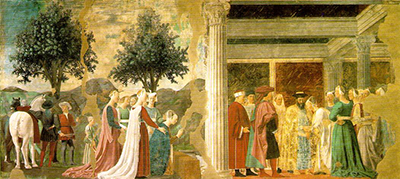Commissioned by the Aretine family, Bicci, The Queen of Sheba, by Piero della Francesca, is a painting of contrasts.
Completed between 1452 and 1466 and measuring 336 x 747 cm, The Queen of Sheba is part of the fresco cycle of the Story of the True Cross – which narrates a medieval tale regarding the cross used to crucify Jesus – and is acknowledged as Piero della Francesca’s masterpiece. Della Francesca’s frescos are housed in the Basilica di San Francesco, a late medieval church, in Arezzo, Italy. He was hired by the Bicci family to complete the work begun by Bicci di Lorenzo who died in 1452.
Della Francesca deliberately paints two separate episodes in the same fresco, separated by a column of King Solomon’s royal palace. On the left, the Queen of Sheba stops on her journey to meet King Solomon in order to kneel in reverence before a piece of wood at a stream. Legend recounted that a branch from the tree of knowledge planted on the tomb of Adam grew into a large tree. Later, this tree was cut down by the servants of King Solomon to construct a bridge over the stream. In a vision, the Queen of Sheba is told that the cross upon which the Romans crucified Jesus was made from this tree, and it is for this reason she is compelled to kneel in veneration.
Della Francesca allows the story to further unfold on the right of the fresco wherein the Queen bows before King Solomon while he holds her hand. The Queen of Sheba’s actions in this second episode is difficult to interpret: Does she wish to pay her respect to the wisest of humans, yet he prevents her from doing so by holding her hand? Or does she intend to kiss the king’s hand, and he in turn he allows her this honour? In further analysing the two episodes, we see the stark contrast between male and female: King Solomon’s retinue is made up solely of men, while in the Queen of Sheba’s retinue we find only young women.




